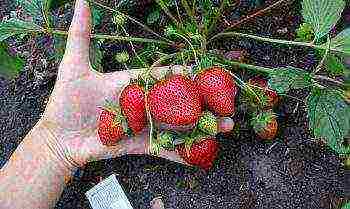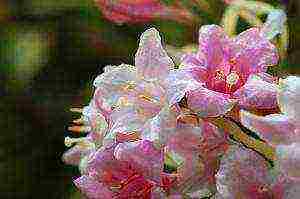Content
In the 80s and 90s of the last century, when Atkins with his protein diet was at the peak of popularity, horns, noodles and spaghetti were suddenly declared persona non grata. The public was convinced that pasta, like any carbohydrate food, made people get fat, and the public reluctantly began to bypass them in stores. This myth is still alive. Many losing weight are sure: the first thing to exclude from the diet is bread and pasta. How wrong they are!
In fact, durum wheat pasta is a light and dietary food. A glass of boiled spaghetti contains only 130-140 kcal and a lot of "slow" carbohydrates, which give us energy, saturate well and help maintain a stable blood sugar level. They have a lot of fiber, which removes all unnecessary (toxins, heavy metal salts, etc.). Those who are overweight and have digestive problems need to eat pasta! However, everyone else benefits from them too.
Pasta makes us happy ... During cooking, a large amount of tryptophan is formed, an amino acid that enters the brain through the blood and is converted into the "happiness hormone" serotonin.
... and smart - due to the content of B vitamins necessary for the brain.
They keep us young. Pasta contains vitamins E and F, which slow down the appearance of wrinkles.
Season them in the Italian style with olive oil, tomatoes, garlic and basil - they will also protect against cancer!
But all this applies only to durum wheat pasta. They contain little starch, it is contained in a special crystalline form and is absorbed without harming the figure. In many countries - Italy, France, Greece, etc. - there are simply no other pasta. Unfortunately, our horns, noodles and spaghetti are still made from soft wheat. The starch is there in an amorphous form, which, in terms of its ability to influence weight, equates them to white bread. After cooking, all valuable substances remain in water, and the shape of the products after cooking leaves much to be desired.
The GOST acting in Russia divides all the pasta variety into three groups:
BUT - from durum wheat,
B - from high glassy soft wheat,
IN - from soft wheat.
And also for two classes:
- from flour of the highest grade,
- from flour of the first grade.
On a pack of "correct" pasta, which is only a joy to our waist, one of the inscriptions should be present: "Group A, 1st class", durum, "durum wheat" or semolina di grano duro.
So, the perfect pasta ...
✓ translucent, pure, even, amber-yellow or golden in color, without whitish inclusions (white dots are found in soft pasta varieties);
✓ they have a lot of protein... Look at the composition: protein should be at least 11 g / 100 g, better - 13-14 g;
✓ bend well, while products from soft varieties, on the contrary, quickly break;
✓ increase in volume during cooking not less than 2 times, retain their shape well. They are soft, elastic, do not form lumps and do not stick together. Cloudy cooking water indicates that there is a lot of starch in them. This happens after making cheap horns, but not noble fusilli.
To appreciate both taste and benefit
- boil pasta in plenty of water. The classic cooking ratio is 1000: 100: 10 (1 liter of water, 100 g of pasta and 10 g of salt);
- cook until al dentewhen they are a little hard when biting through;
- do not pour pasta dishes with greasy sauces and butter. It is advisable to cook the sauce yourself or use ready-made tomato sauce;
- sprinkle the pasta with finely grated Parmesan cheese: it is no less high in calories than other hard cheeses, but there is more taste in a tablespoon of this cheese. More dietary options are also unexpected and good: Adyghe cheese, feta cheese, or even low-fat grained cottage cheese;
- cook them differently. Pasta goes well with fish, vegetables, herbs. Still, the main secret of pasta cuisine is sauces. In Italy, they are cooked only with olive oil, which stimulates digestion and activates the liver.
Talking names
Traditionally in Russia all kinds of pasta are called pasta (from the word "dough"). However the Italian term maccheroni refers only to short tubular products, the rest have their own names. Spaghetti - long, rounded and thin enough (translated as "small ropes"). Capellini - also long, rounded and even thinner, they are also called "angel hair". Bavette look like flattened spaghetti, etc. In total, there are over 600 different forms of pasta in the world, so the list can turn out to be impressive, we will not list it.
Expert opinion
Tatiana ANOKHINA, head of the test center of the SEAC "SOEKS" of the Chamber of Commerce and Industry of the Russian Federation.
Six samples of pasta have been tested in our laboratory. And in the end we give all of them high marks! Physicochemical indicators of the subjects meet the standards of GOST 31743-2012. Their moisture content (a very important indicator that determines how long pasta will be stored) does not exceed 13%. Acidity (the taste and freshness of the product depend on it, and it can increase if the dough or raw products have been in a humid environment for a long time) - no more than 40, which is within the normal range. We did not find any pests, plant GMOs, toxic or any other harmful elements in the samples.
Text: Evgeniya Danilova
Nevertheless, a competition is a competition, and we must name the winners. The best, in our opinion, were the Baronia spaghetti, the silver was received by the Maltagliati spaghetti, and the bronze by Makfa.
Test: Spaghetti *
| De Matteis Agroalimentare S.P.A., Italy | LLC "MakProm", Saratov region | LLC Pasta factory "AMERIA", Kursk region. | OOO TD "Oskol", Belgorod region, Spain | JSC "MAKFA", Chelyabinsk region | Not specified, importer CJSC InfoLink, Moscow |
| Durum wheat flour, water | Durum wheat flour, water | Wheat flour for special purposes, type М55-23, water | Premium durum wheat flour, water | Premium durum wheat flour, water | Durum wheat flour, water |
| Compliant | Compliant | Compliant | Compliant | Compliant | Compliant |
| 354 | 350 | 340 | 344 | 338 | 355 |
| 13,5 | 13 | 10 | 10,4 | 11 | 12 |
| 9 | 10,4 | 10,8 | 10,2 | 10,1 | 9,7 |
| 2,6 | 1,2 | 1,4 | 1,4 | 1,6 | 2,0 |
| 7,7 | 5 | 5,9 | 5,3 | 5,9 | 7 |
| 100 | 100 | 100 | 100 | 100 | 100 |
| Not detected | Not detected | Not detected | Not detected | Not detected | Not detected |
| Yellow, long threadlike | Yellow, long threadlike | Pale yellow, long threadlike | Yellow, long threadlike | Yellow, long threadlike | Pale yellow, long threadlike |
| 500/70 | 450/45 | 400/30 | 450/40 | 500/58 | 500/88 |
| This is exactly what the winner should be - tasty, beautiful, healthy (a lot of fiber and protein) and persistent (judging by the moisture and acidity indicators, it will be stored well and for a long time). Well deserved first place! | The Shebekinskys stopped a step away from the bronze: in most parameters they are slightly inferior to Makfa. But not in terms of protein content - here they come very close to the winner! | These pasta are a clear outsider: they have less protein than competitors, and they retain their shape worse after cooking. Which, in general, is understandable: these spaghetti are the only ones from group B, that is, they are made from soft wheat. | The taste and color of these pasta is excellent, but the rest of the indicators are average. Before us is the classic middle peasant. | It's nice that the quality of pasta produced by domestic producers is not much inferior to Italian ones. I wonder if the Italians put them on a plate, will they notice the substitution? | Very tasty and, what is important, beautiful spaghetti.If we were only evaluating the appearance after brewing, then Maltagliati would take first place. They are slightly inferior to the winner only in protein content. |
* Thank you for your help in conducting the SEAC "SOEKS" test
Some people think that all pasta is the same and there is no difference between them, so you should take the cheapest one. Others, on the other hand, have extensive knowledge of the classification of pasta and have almost a dozen different options in the kitchen. Pasta is actually very diverse - not only in terms of shape, but also in terms of taste and composition. At the same time, the choice of pasta is not something difficult and requires significant knowledge - the only difficulty may lie in the search for products with an optimal price-quality ratio.
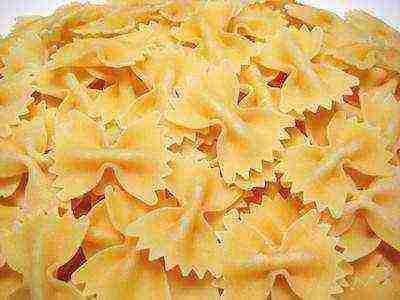
Groups A, B and C
On the packaging of pasta, you can find information about which group they belong to. Group A is preferable to the other two. However, most pasta belongs to it. Sometimes you can find pasta of groups B and C - as a rule, these are the cheapest options, for example, "Red Price" from Pyaterochka and Perekrestok.
What does the phrase "group A" mean? That the pasta was made from durum wheat flour, which is high in gluten and low in starch. Durum wheat pasta tastes better and has a lesser effect on blood sugar (which is important, for example, for people with diabetes).
Group B pasta is made from flour obtained from the so-called soft wheat; Group B pasta - made from bakery flour.
Varieties
Pasta can be of the highest, first and second grades - depending on what kind of flour is used for their production. Now, in my opinion, only premium pasta is sold. I have not met anyone else. Naturally, the highest grade is better than the first and second.
Russian or Italian?
Why pay big bucks for Italian pasta when Russian ones are just as good? - this is how many buyers reason. Often this question does not arise at all for the buyer: he takes a package of pasta, focusing only on the price, brand or design of the package itself.
Indeed, quite decent pasta is produced in Russia, and they sometimes turn out to be tastier than budget Italian counterparts. Another thing is that now many Russian pasta are priced like budget Italian ones - if you take Italian ones, produced by order of large chains (Magnit, Perekrestok). For example, the Shchebekinskie macaroni made in Russia cost a little more than the Pasta del Ricci brand macaroni produced in Italy by the order of x5 Retail Group.
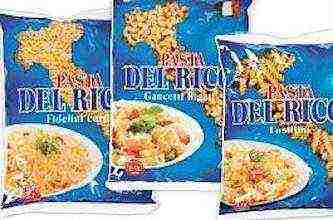 In any case, the best Italian pasta tastes better than the best Russian ones; Moreover, they are much more diverse - there are more than a hundred varieties of Italian pasta in total! And many of them are available in Russian retail. Handmade pasta stands out especially, but now they are already very expensive.
In any case, the best Italian pasta tastes better than the best Russian ones; Moreover, they are much more diverse - there are more than a hundred varieties of Italian pasta in total! And many of them are available in Russian retail. Handmade pasta stands out especially, but now they are already very expensive.
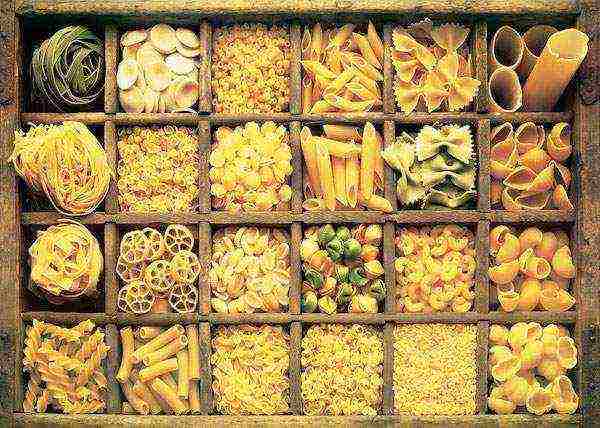 Keep in mind that now, with the rise of globalization, pasta of Italian brands is no longer necessarily made in Italy. A striking example here is Barilla - some of the pasta of this brand is made in Greece, so if this is critical for you, you need to look at the labeling on the packaging.
Keep in mind that now, with the rise of globalization, pasta of Italian brands is no longer necessarily made in Italy. A striking example here is Barilla - some of the pasta of this brand is made in Greece, so if this is critical for you, you need to look at the labeling on the packaging.
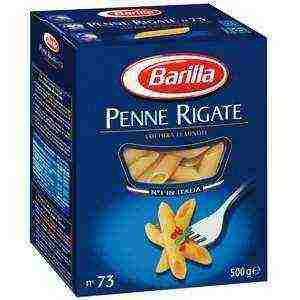
Some interesting facts:
- Italy produces pasta mainly from wheat imported from the United States and Canada.
- All Italian pasta belongs to group A, because the production of pasta of other groups in this country is prohibited.
- As a rule, pasta of real Italian brands is sold in 500-gram packs, and pasta produced in Italy by order of Russian retail chains is sold in 450-gram packs. Russian pasta is packed in packages of either 450 or 400 grams; 500 gram packs are much less common.
- The most popular Italian brand Barilla pasta in Italy itself costs 1.8-2.4 times cheaper than in Russia.
Weight of packing
When comparing prices for pasta from different brands, pay attention to the weight of the package.Usually there are three options: 400, 450, 500 grams. Sometimes there are 200, 250, 350 grams. For example, pasta for 45 rubles / 450 grams and pasta for 50 rubles / 500 grams are exactly the same per kilogram, and some elite Italian pasta for 100 rubles / 250 grams is more expensive than pasta for 50 rubles / 500 grams, not two, but four times.
Varieties of Italian pasta
There are just a lot of them! I will mention only the most common ones available in Russian stores.
Farfalle ("Butterflies", "bows") - one of my favorite varieties. They are convenient to eat, they look original and beautiful. Small "butterflies" are called farfalette or farfallini. In Russia, in my opinion, pasta of this form is not made.

Fettuccine, pappardelle, tagliatelle - a kind of long stripes with a width of 7, 13 and 5 millimeters, respectively. It is inconvenient to eat them without proper skill.
 Fusilli, fusillini - spirals, "spindles", if literally translated from Italian; they are made in large quantities in Russia. Fusilli is larger than fusillini; generally "-ini" indicates a reduced size of the item.
Fusilli, fusillini - spirals, "spindles", if literally translated from Italian; they are made in large quantities in Russia. Fusilli is larger than fusillini; generally "-ini" indicates a reduced size of the item.
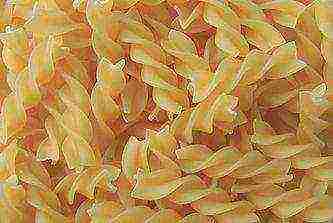 Penne rigate - tubules with oblique cuts and a ribbed surface. There is also a subspecies Penne lisce - with a smooth surface.
Penne rigate - tubules with oblique cuts and a ribbed surface. There is also a subspecies Penne lisce - with a smooth surface.
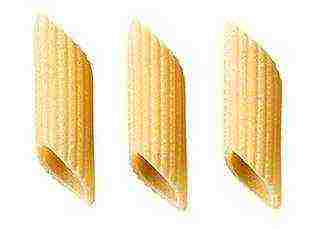 Cannelloni - very thick, but short pasta with large cavities inside, which are supposed to be filled with minced meat and baked.
Cannelloni - very thick, but short pasta with large cavities inside, which are supposed to be filled with minced meat and baked.
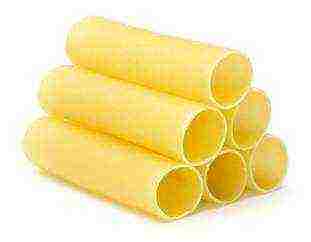 Lasagna - plates used to make lasagna.
Lasagna - plates used to make lasagna.
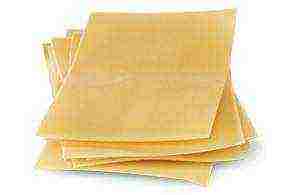 Maccheroni - in fact, this is pasta (it is not entirely correct to call other types of pasta pasta). Classic tubes, rather thick and short.
Maccheroni - in fact, this is pasta (it is not entirely correct to call other types of pasta pasta). Classic tubes, rather thick and short.
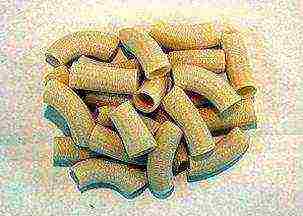 Vermicelli - what we know as vermicelli. The name comes from the word verme, which means "worms" in Italian. This is a very thin medium-length pasta.
Vermicelli - what we know as vermicelli. The name comes from the word verme, which means "worms" in Italian. This is a very thin medium-length pasta.
 Spaghetti - classic spaghetti, long and thin. There is a smaller version: spaghettini.
Spaghetti - classic spaghetti, long and thin. There is a smaller version: spaghettini.
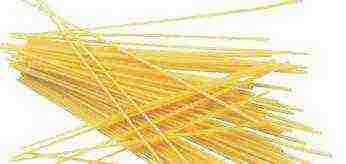 Conchiglioni - giant "shells" that can be filled with filling.
Conchiglioni - giant "shells" that can be filled with filling.
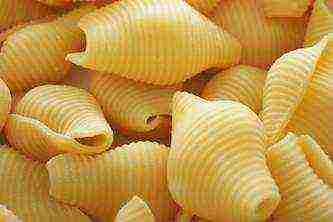
Colored pasta
The so-called colored pasta is especially worth highlighting. They, like their "colorless" counterparts, are available in various forms. High-quality colored pasta is colored only with natural dyes: red color is achieved by adding tomatoes, green - spinach. Cuttlefish ink can be used to produce a very dark color.
Colored pasta is more expensive than "colorless". Some of the most affordable in Russia are colored pasta brands DonnaVera (Magnet, 45 rubles) and pastaZara (Perekrestok, Victoria, 60-65 rubles). Both are made using only natural supplements.
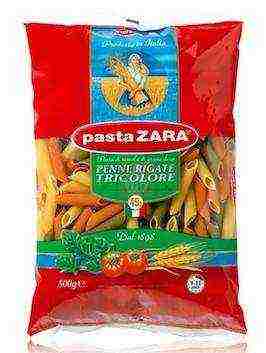
Handmade pasta
Such a paste is expensive. Often it looks elegant and original, but it also happens to be quite standard in appearance. It usually costs 150 or more rubles per package, and the package may not be 500 grams, but only 200-250. Rather suitable for gifts and special occasions.
Some brands, prices and personal experiences
Red price - some of the cheapest pasta. Sold in Pyaterochka and Perekrestok, cost 9-10 rubles for a 400-gram package. The only pasta on the list belonging to group B (the rest are group A). In my opinion, this is a classic example of a product from the “cheap and cheerful” series. The taste is pretty mediocre.
Okay - a good budget option. They are in Perekrestok and Pyaterochka, they cost about 20 rubles per 400 grams.
Just Pasta - in my opinion, excellent, with an excellent price-quality ratio. It is a pity that I met them only in one non-chain store, and that was about a year ago. They cost 15 rubles / 400 grams.
Schebekinskiy - regular pasta, nothing special. The price, in my opinion, is overpriced. In Ashan - 36 rubles / 450 grams, in Pyaterochka - 37 rubles, in Perekrestok and Victoria - 39-40 rubles.
Makfa - a little cheaper, but again not the best value for money. "Mediums" at a fairly high price. In Ashan - 32-33 rubles / 450-500 grams (depending on the variety), in Pyaterochka - 32-35 rubles, in Crossroads and Victoria - 36-37 rubles.
Veroni - sold in Magnets, cost a little more than 20 rubles for a 400-gram package. Delicious, good value for money.
Now let's move on to Italian pasta.
PastaZara - in my opinion, an excellent price-quality ratio. They cost 50 rubles / 500 grams (colored - 63-65 rubles, natural supplements). They meet in Auchan, Crossroads.
Barilla - not bad, but a little expensive.Overpayment for the brand and for a beautiful cardboard box. Pleases with a wide assortment, even in Russia. In Ashan - 70-75 rubles / 500 grams, at the Crossroads - from 80 rubles, in Magnolia and Victoria - from 90 rubles.
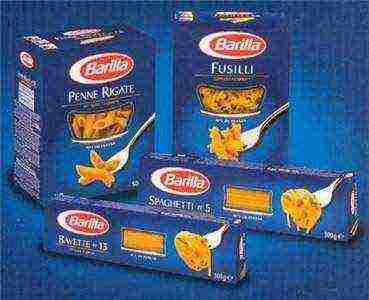 Trattoria di Maestro Turatti - Crossroads, 49 rubles / 450 grams. Made in Italy for x5 Retail Group. Nothing special.
Trattoria di Maestro Turatti - Crossroads, 49 rubles / 450 grams. Made in Italy for x5 Retail Group. Nothing special.
Pasta del ricci - are in Perekrestok and Pyaterochka, they cost 36 rubles / 450 grams. Similarly - Italy, but ordered by x5 Retail Group. Good value for money.
DonnaVera - sold in Magnet, made in Italy by order of Tander. They cost 45 rubles per 450 grams (in the "color" version). Excellent value for money in my opinion.
ItalPasta - also made in Italy by order of CJSC "Tander" (Magnit). They cost just over 30 rubles per 450 grams. In my opinion, quite ordinary, but at the same time quite decent pasta. However, I don't want to buy again. By the way, it seems that there is still another brand Italpasta, but I have not met its pasta in Russia.
Maltagliati - an original Italian brand; pasta of this brand can be found in Auchan and Victoria, cost about 60 rubles per 500 grams. Not a bad option, it is quite possible to buy.

Two main degrees of cooking
If in Russia pasta is cooked "to the end" and completely softened, then in Italy another method is widespread - "al dente", when the pasta is not cooked "to the end", and the middle remains a little hard and damp. It is believed that pasta al dente is healthier and tastier.
In most cases, the cooking time recommended by the manufacturer is indicated on the paste packaging.
24.07.2017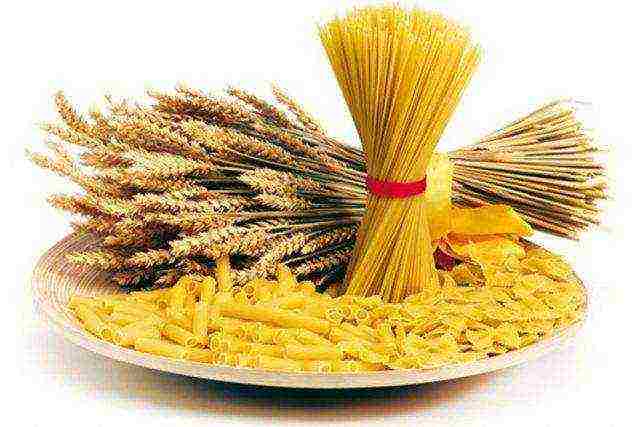
Good pasta or pasta, consists only of durum wheat flour and water.
Since about the 14th century, the main difference between pasta is considered to be its division into fresh (pasta fresca) and dry (pasta secca).
Fresh pasta is prepared at home or in restaurants. Eggs, spinach, beets and other ingredients can be added there.
Such pasta is not stored for a long time, but is usually cooked and eaten immediately after cooking.

Dry pasta is produced on an industrial scale. They have a long shelf life. These pasta can be bought at almost any store.
But in order to get a quality product that will benefit you, and not extra pounds, you need to know how to choose the right pasta.
I will not consider pasta with the addition of eggs, buckwheat or rice flour. The information below only applies to classic pasta made from wheat flour.

In short, here are the points by which you can determine high-quality pasta before buying in a store:
- The composition on the label indicates one of these options:
- "Group A"
- "1st class" (premium flour),
- "Durum",
- "Durum wheat"
- "Semolina di grano duro"
- The protein content is not less than 12 g per 100 grams of pasta. The bigger, the better;
- Pasta should have a smooth surface and smooth and glassy edges;
- The color is yellow, gold or amber;
- The package is completely absent or present minimal the number of crumbs and broken pieces of pasta.
Now more about the quality of pasta.

Navigation through the article:
Composition of pasta
Groups of flour from which pasta is made in Russia
To choose the right pasta, you first need to study the composition on the pasta label. The composition should contain only durum wheat flour and water.
Flour, which is used for the production of pasta in Russia, divided into 3 groups... Groups are designated by Russian letters A, B, C.
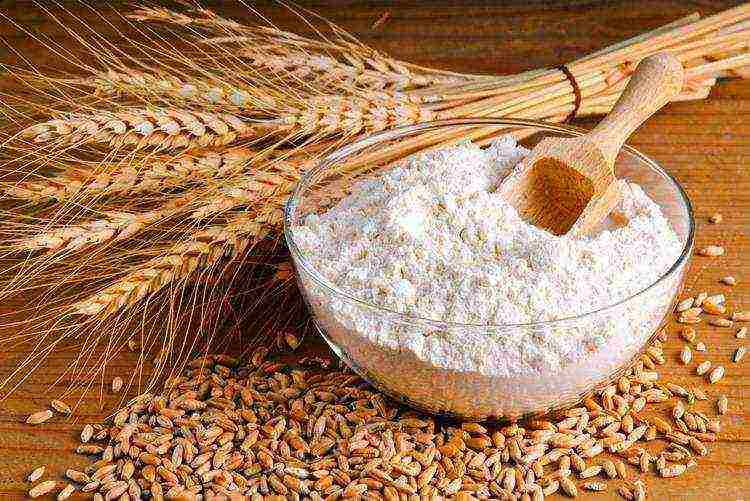
A - durum wheat flour or durum
Pasta made from group A flour has a low glycemic index and is rich in fiber, vitamins and minerals.
The water after boiling such pasta remains almost transparent. The pasta itself does not stick together during cooking and keep its shape well after.
On the packaging in the composition of the ingredients, such flour may be called:
- group A;
- 1st class (premium flour);
- "Durum";
- durum wheat;
On packages of pasta that were exported from Italy, they usually write:
- Semola di grano duro;
- Farina di grano duro;
- Semola di frumento duro.
B - soft glassy wheat flour
Class B flour pasta contains a large amount of starch. Such a product contains fewer beneficial nutrients for the body. The water will be cloudy during cooking. Such pasta will stick together during and after cooking.
On the package in the composition, such flour may be called:
- group B (soft flour);
- flour of the first and highest grade;
- Grade 2.
B - soft bakery flour
White pasta made from flour group B. They are very fragile, so there will be a lot of broken pasta, fragments and crumbs in the package. When boiled, they are very soft. By consuming such pasta, you can quickly gain excess weight.
On the package in the composition, such flour may be called:
- group B;
- soft wheat flour;
- baking flour.
Protein content in pasta
After you have found information on the packaging of pasta that it is made from durum flour, then you need to find the amount of protein in the product.
You can indirectly determine the amount of soft flour in pasta by the amount of protein. The more it is, the higher the chance that the durum pasta contains no other flour impurities.
Good pasta contains minimum 12 g protein per 100 g pasta. The higher the indicator, the better the pasta.
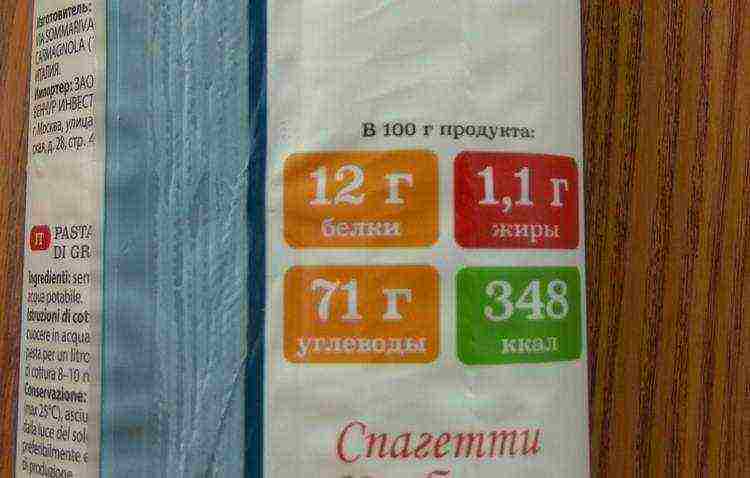
If the protein value on the package is below 11 g per 100 grams of pasta, then most likely flour of lower grades was added to the flour of group A. This means that most likely in front of you is a low-quality product.
According to the President of the Russian Grain Union of the Russian Federation Arkady Zlochevsky, the mass fraction of protein in pasta indirectly suggests that low-grade raw materials were used in production. Protein is a parameter that is related to the growing conditions of wheat. Hot and dry weather without drought contributes to the high protein content of the grain. Frosts and rains, on the contrary, lead to its decrease.
Glycemic index (GI) of pasta
Vegetables, fruits, legumes, brown rice, buckwheat and durum pasta (prepared "al dente") are classified as low glycemic foods. They give their energy to the body gradually.
| Al dente durum wheat pasta | 40 |
| whole grain whole wheat pasta | 38 |
| Durum wheat pasta | 50 |
| Premium pasta, group B | 75 |
Indicators are approximate. The amount of GI depends on the specific type of pasta.
It is worth noting that the glycemic index is not related to calories. A low GI food can be high in calories. Consider this if you are on a diet.
Calorie content, composition and BJU pasta
The calorie content of pasta and nutritional value, namely the amount of BJU (proteins, fats, carbohydrates), may differ. For example, I will take 3 packages of different brands of spaghetti, which are made from different types of flour.
Calorie content of durum wheat pasta, durum, Group A or Extra *:
Makfa brand spaghetti made from durum wheat (GOST 31743):
| Nutritional value of 100g of products: | |
| proteins | 12.5 g |
| fat | 1.3 g |
| carbohydrates | 70.5 g |
| alimentary fiber | 3.7 g |
Caloric value: 344 kcal
Energy value: 1439 kJ
Spaghetti n.5 of the "Barilla" brand. Group A. Superior grade. (TU 9149-012-48774716-14):
| Nutritional value of 100g of products: | |
| proteins | 11.2 g |
| fat | 1.6 g |
| carbohydrates | 72.2 g |
| alimentary fiber | 2.4 g |
Caloric value: 359 kcal
Energy value: 1502 kJ
Spaghetti brand "Schebekinskie" Group A. The highest grade. (GOST 31743-2012)
| Nutritional value of 100g of products: | |
| proteins | 13 g |
| fat | 1.5 g |
| carbohydrates | 72 g |
| alimentary fiber | Not specified |
Caloric value: 350 kcal
Energy value: 1464 kJ
Calorie content of soft flour pasta, groups B *:
- Spaghetti Ameria No. 3, from general purpose wheat flour, type M55-23. Group B (GOST 31743-2012)
- Spaghetti No. 4, Extra-M. Group B, top grade (GOST 31743-2012)
- Saomi Vermicelli long, spaghetti. Top grade (GOST 31743-2012)
These pasta from flour group B have the same BZHU and calorie values:
| Nutritional value of 100g of products: | |
| proteins | 10.4 g |
| fat | 1.1 g |
| carbohydrates | 71.5 g |
| alimentary fiber | unknown |
Caloric value: 344 kcal
Energy value: 1439 kJ
* according to the Utkonos online store (07/23/17), which are indicated in the pasta product card.
Let's compare the average values of calorie content and BZhU of pasta from durum wheat of group A and indicators of pasta from soft flour of group B:
| Nutritional value per 100g: | Group A | Group B |
| proteins | 12.23 g | 10.4 g |
| fat | 1.46 g | 1.1 g |
| carbohydrates | 71.56 g | 71.5 g |
| alimentary fiber | 3.05 g | unknown |
| Calorie content | 351 kcal | 344 kcal |
| The energy value | 1468 kj | 1439 kj |
For durum pasta and for soft flour pasta, the indicators do not differ very much. The table shows that durum pasta has a large amount of protein, fat and calories. The indicators of carbohydrates in the varieties are approximately equal. The amount of calories in pasta made from soft flour is less.
The advantage of durum wheat is that it has a lower starch content. Therefore, you will receive less benefit from pasta made from soft flour, and the chance of gaining excess weight is greater.
Pasta structure
The presence of dark and dark yellow dots on the surface of pasta is the result of grinding whole grains. This means that such pasta will have more beneficial nutrients.
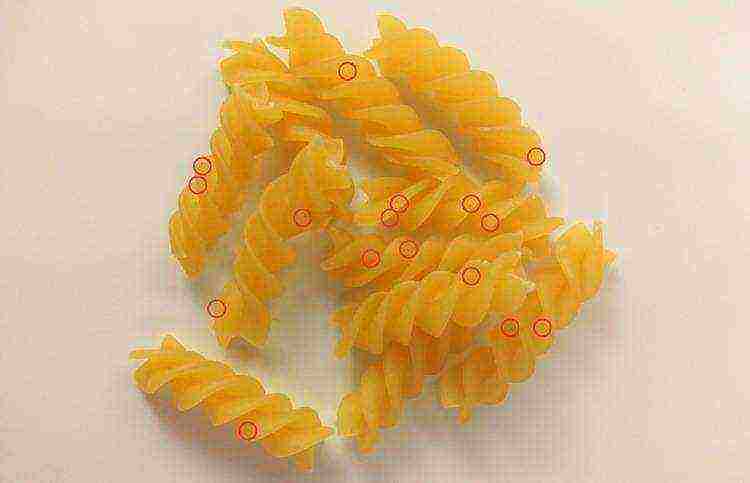
White specks and roughness on the pasta are a sign of poor-quality flour from which they were prepared. It may also indicate a violation of technology or poor test production in production.
Shelf life of pasta
The shelf life of pasta directly depends on moisture characteristics... The moisture content of the product must be balanced. This means that if the pasta is overdried, then it will break in the package even at the stage of transportation to the store, and if it is too wet, then there is a chance of mold.
GOST requires manufacturers to observe the moisture content of pasta no more than 13%, and in products for baby food no more than 12%.
Also affects the shelf life acidity product. The higher it is, the less pasta will be stored.
The increased acidity of pasta can be the result of a violation of the drying regime, as well as the use of poor-quality flour in the batch. The acidity should be no more than 3.5-4.
Usually shelf life of pasta from durum wheat is from 24 to 32 months. Subject to storage conditions (temperature no more than 40'C and relative humidity no more than 75%).
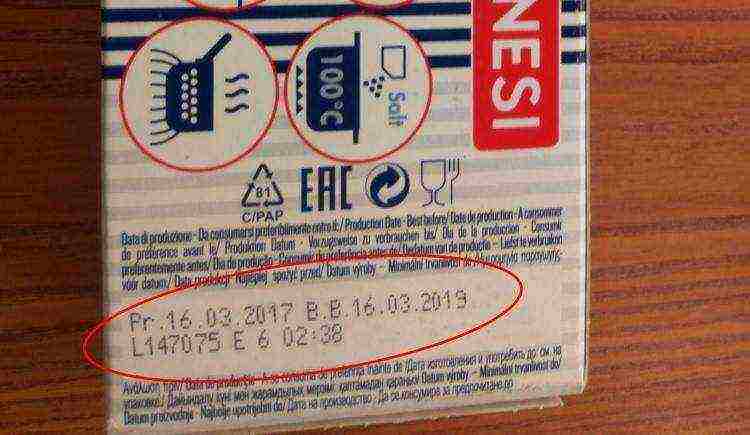
Colored pasta
On store shelves, you can find pasta not only in different shapes and sizes, but also in different colors.
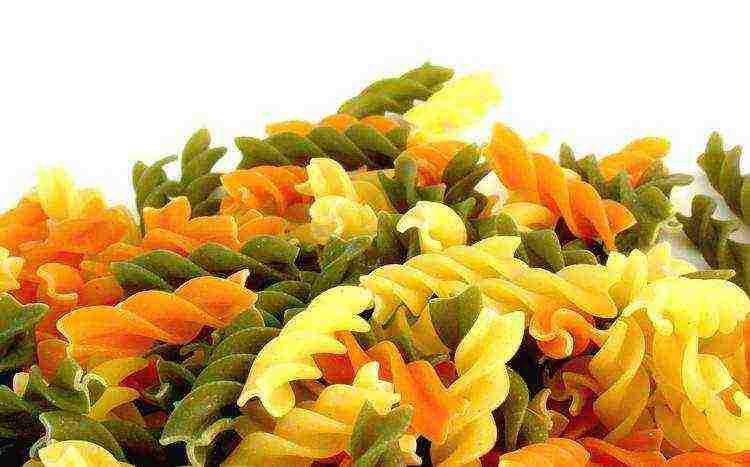
The manufacturer paints pasta in red, green, black and other colors. Thus, in addition to color, such pasta receives the aroma and delicate taste of natural dyes, such as:
- Carrot juice
- Beet juice
- Spinach
- Cuttlefish ink, etc.
Such products may differ from simple ones with a reduced shelf life, otherwise they are the same pasta. But again, read the composition. If it contains additives with the “E” code, leave such a product on the shelf.
How to choose quality durum wheat pasta?
How to choose pasta by appearance?
After you have read the composition and found durum flour there, as well as the amount of protein above 12 grams, then it is worth looking at the pasta itself. Most manufacturers sell their product in translucent packaging, so it is not difficult to identify quality pasta.

Durum wheat pasta have the following properties:
- The color is golden, yellow, amber;
- The surface is smooth;
- Glassy edges;
- There are no debris or crumbs in the package, or a minimum of them.
Soft Wheat Pasta can be determined by the following criteria:
- The color is white, pale yellow or, on the contrary, poisonous yellow;
- The surface and fracture of macaroni are rough;
- White dots on pasta due to unmixed dough;
- There are a lot of pasta debris and crumbs in the package.
Irina Makhanova, head of the food research department of the Center for Hygiene and Epidemiology of Rospotrebnadzor in the Chelyabinsk Region, notes that the presence of crumbs and scrap in packaging helps to further characterize pasta, both from a qualitative and aesthetic point of view. Strength directly depends on the quality of the flour and the drying mode. The number of broken pasta in a package is an indicator of compliance with technological processes in production.
How to check the quality of pasta at home?
You can check the quality of the pasta at home when you have already bought it.
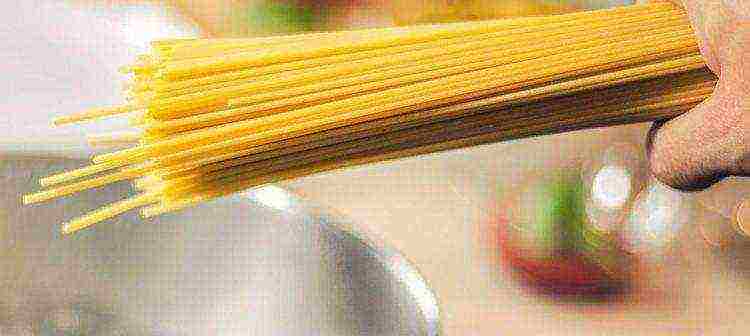
If you purchased, for example, spaghetti, then you can check their quality by the following indicators:
- Elastic... Spaghetti from soft varieties or a mixture of flour will easily break with your hands, from hard varieties they will be elastic and will bend to the last.
- Do not stick together... Good pasta does not stick together into lumps during cooking and does not boil too much.
- Do not muddy... The water should not be cloudy. White and sticky water after boiling pasta testifies to their low quality pasta, they contain a lot of starch.
- Do not change color... After boiling, the pasta remains golden yellow in color.
- Keep in shape... Even if you leave them in water for an hour, they will not swell several times and will keep their shape.
After cooking, pasta should retain its appearance and the same shape.what they had in the package.
If you take boiled spaghetti as an example, then split ends and differences in diameter along the length of the pasta will mean poor product quality.

Pasta made from soft flour is very boiled during cooking, and after that it sticks together and does not keep its shape well.
High-quality durum wheat pasta is practically devoid of these disadvantages. It is enough to mix them several times during cooking, and then add a little oil to the finished pasta.
How much does good pasta cost and how to buy quality pasta?
Quality durum wheat pasta do not sell by weight... They are always offered in individual packages. So they retain their useful properties longer and do not deteriorate under the influence of air and moisture.
If the pasta is made in Europe or the USA, then the words on the label can be trusted, unless of course it is a fake. They have stricter food quality control. Most of them offer you a quality product made from good wheat. But check the composition on the label anyway before buying. Import is not a panacea.
Good pasta made from flour group A and high protein always will cost more macaroni made from flour group B and C. But an unscrupulous manufacturer or store can artificially increase the price for a brand, packaging or imported products. Therefore, always read the composition before buying. Don't let yourself be fooled.
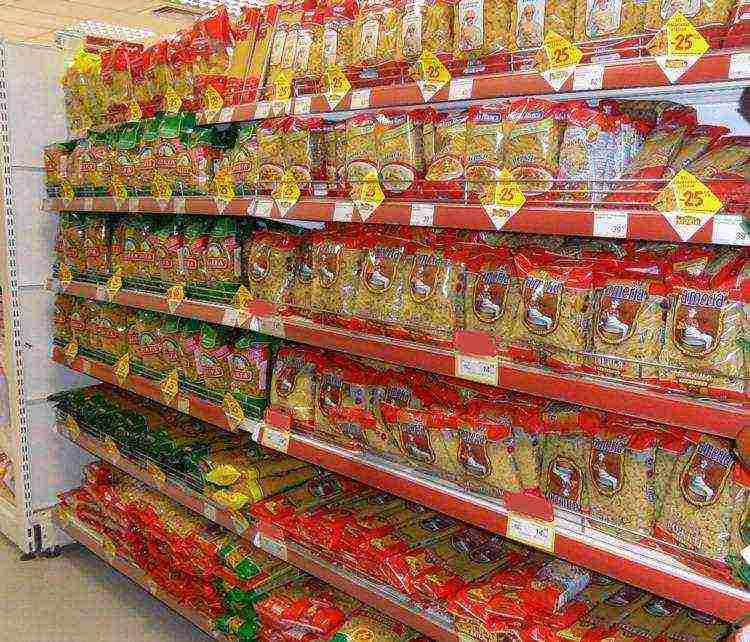
High-quality pasta is unlikely to cost less than 50-60 rubles. For a lower price, you are most likely offered pasta made from a mixture of flours of different varieties or unformatted. A good pasta is even more expensive, and a very good one can be offered for 150-250 rubles.
Doubt. Check it out for yourself. Buy 2 packs of spaghetti. One from the segment is 20-40 rubles, and the other from 100-150 and try to cook them at home. I'm sure you will feel the difference.
I usually buy pasta at the supermarket closest to my house. But sometimes it is a shame to waste time on shopping trips. I would love to order groceries with delivery, but in Yekaterinburg everything is sad with this case. But if you are from Moscow, you can buy pasta and other products in the Instamart online store with delivery. If there was a similar service in my city, I would love to use it.
The harm and benefits of pasta
Why is pasta harmful?
Pasta is a flour product. Like other flour and bakery products, pasta has a low nutritional value, a relatively high glycemic index (especially from soft varieties), and is also high in carbohydrates.
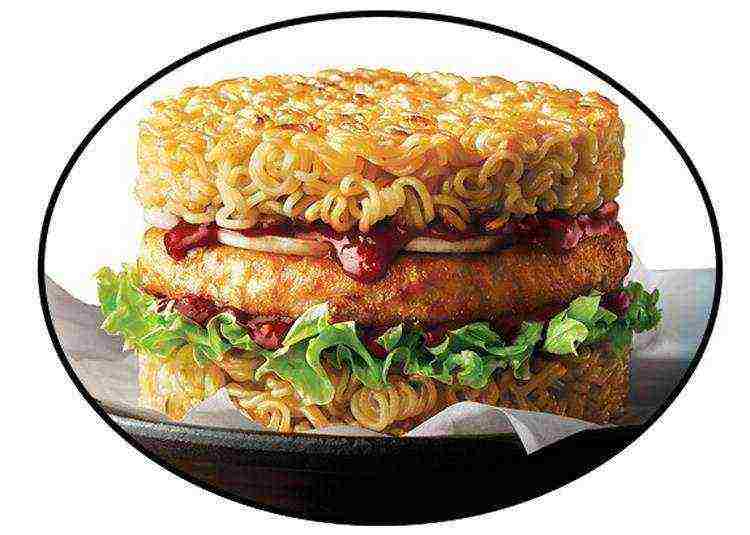
Pasta can harm the digestive system and the body.For example, pasta is contraindicated in people with acute pancreatitis. Their strict diet does not allow them to eat flour products.
With chronic pancreatitis, pasta can be eaten, but with restrictions. The fact is that products made from durum wheat flour give an additional load on the pancreas and pushes the body to excrete more bile. If intestinal motility is increased, then pain may occur, and after stool disturbance.
To eliminate these negative aspects for people with pancreatitis and gastrointestinal disorders, you need to cook pasta as follows:
- Cook until the end and even overcook a little to remove most of the starch. Forget about al dente;
- It is advisable not to fry the ingredients and the pasta themselves in oil, and also not to allow a very fried crust when baking or frying;
- Add only a small amount of oil to finished pasta;
- Eliminate hot and salty sauces.
- It is also recommended to eat pasta in the morning. For dinner, pasta can be too heavy a meal.
For those who follow the figure, you should simply combine the pasta with stewed vegetables and sauces based on them. This will maximize your pasta benefits and not get a lot of calories.
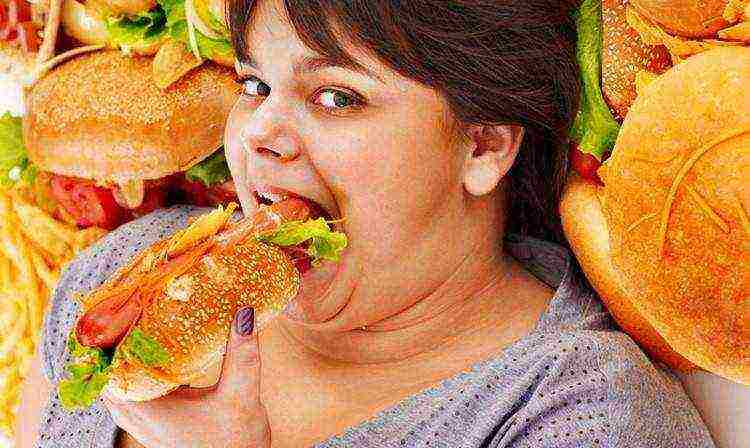
In general, from a weight loss point of view, it doesn't make much difference what pasta you eat. More importantly, in addition to pasta, you also eat, and what is the total amount of your calories per day.
If we consider pasta from the point of metabolism, then it is better to buy pasta from whole grains of durum wheat.
The benefits of pasta
Good quality durum wheat pasta, cooked al dente and seasoned with a little olive oil, is perceived by the human body as bran. These pasta stimulate the intestines and push the digestive system to create more bile for better digestion.
High-protein durum pasta is a healthy food item and is recommended in many diets.
By its composition, pasta is highly concentrated fiber and complex carbohydrates. Fiber is hardly absorbed by the body. It helps to remove toxins from it. In the meantime, this process takes place, it creates a feeling of satiety.
Pasta also contains minerals and vitamins such as potassium, calcium, iron, magnesium, vitamin B3, B6, B12, E, etc.

Pasta contains "good carbohydrates" that slowly deliver sugar to the body. Carbohydrates are consumed by the body gradually and almost completely. The process is slow, so the appearance of problems associated with the regulation of blood sugar levels is minimized.
The amino acid tryptophan, which is found in pasta, boosts the body's production of serotonin. It is a neurotransmitter of good mood, or as it is also called "the hormone of happiness."
Features of durum wheat or durum. Comparison of hard and soft flour
Wheat has thousands of varieties, but among this variety there are 2 large groups, soft and hard wheat.
Soft wheat varieties are mainly grown in high humidity climates. Such wheat occupies a large part of the market. The main manufacturers are located in Russia, Ukraine, Western Europe, Kazakhstan and the CIS, as well as in Australia.
Durum wheat is grown where the climate is drier. In the USA, Argentina, Asia, North Africa and some regions of Russia.
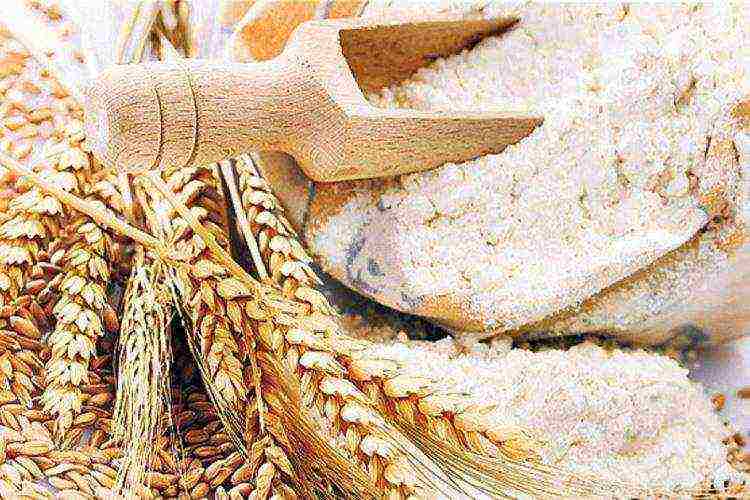
In Russia, durum wheat is mainly represented by spring species. Such wheat needs about 100 warm days to fully ripen. The crop is usually harvested when the grain moisture content reaches 13%.
Not every climate is suitable for growing durum wheat. Durum spring wheat is sown and harvested mainly:
- In the Trans-Urals. In the forest-steppe part of the Chelyabinsk and Kurgan regions;
- On South. In the Krasnodar Territory and Stavropol Territory.
- In the southeast.In the Volgograd, Saratov and Orenburg regions.
- In the Altai Territory and Omsk Region

According to the head of the information and analytical department of the Russian Grain Union Sergei Shakhovets, there is no exact data on the amount of durum wheat. It is not customary to single out and take into account such varieties on purpose. These statistics are usually kept at the regional level. This is most likely due to the fact that durum wheat is grown under the order of large processing enterprises that produce pasta.
Wheat varieties differ from each other in appearance.
Durum wheat is in many ways similar to soft wheat, but it has its own characteristics.
Features of durum wheat:
- Long and dense ear.
- The grain is elongated, tough and small in size. Enclosed in a flower film that prevents excessive shedding.
- The color of the grain is the same. Brownish or yellowish tint.
- Flour from such wheat absorbs liquid well and does not stale for a long time.
The best semolina and pasta are obtained from such wheat.
Representatives are, for example, varieties of spring durum wheat Lilek and Nikolasha, bred by the Research Institute of Agriculture of the South-East.
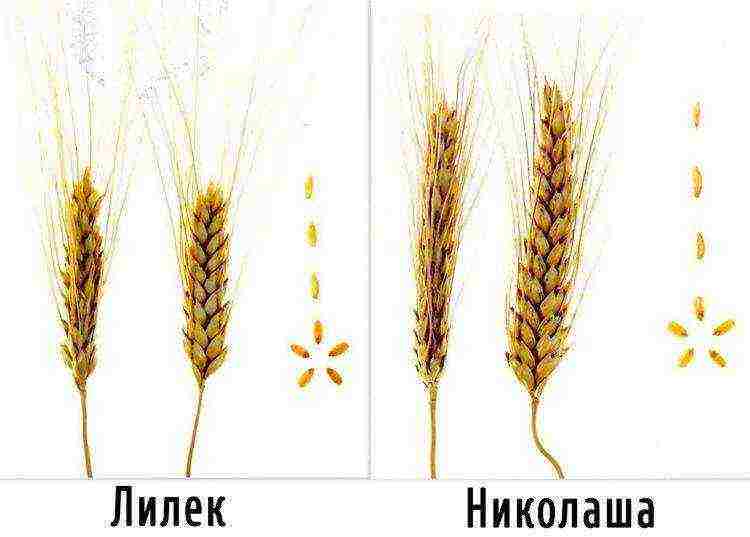
Features of soft wheat:
- The ear has thin walls and more empty space in the straw.
- The grains are larger and softer.
- The color of the grain can be white, yellow, burgundy.
- Flour from such wheat absorbs liquid worse and is subject to rapid hardening.
Flour from such wheat is mainly used for the preparation of bakery and confectionery products.
Representatives are, for example, varieties of winter soft wheat Gubernia and Kalach 60, bred by the Research Institute of Agriculture of the South-East.
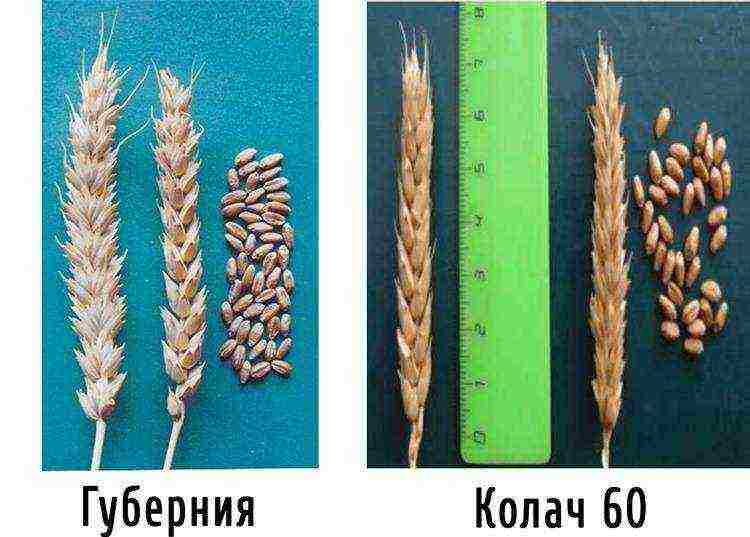
Looking inside, the structure of soft and durum wheat is also different.
In hard pasta, starch has a crystalline structure, in soft varieties it is viscous. So when cooking the latter, a large amount of dry matter and starch passes into the water, which make the water cloudy.
The current GOST allows no more than 6% of dry substances that pass into water.
Igor Pavensky, a leading expert at the Institute for Agricultural Market Studies (IKAR), believes that grain production is directly proportional to the consumption of processed products. And the amount of durum wheat that was grown in Russia can be calculated using data on the production of durum flour. To do this, you need to apply in the calculations the coefficient of conversion of the produced flour into grain, which is approximately equal to 1000 kg of flour from 1330 kg of grain.
The current GOST for pasta. Pasta production in Russia
GOST 31743-2012... Pasta products. General technical conditions.
This standard applies to pasta made from wheat flour and water, including egg and vegetable (with vegetable powders).
Date of publication: June 17, 2013
Date of update: 05.05.2017
Pasta is a familiar and popular product for Russians. Almost every family uses it. Pasta is loved for its ease of use, satiety, good taste and affordable price.
Pasta is an everyday commodity. According to ROMIR Monitorin, in 2014, 94% of the population over 18 purchased pasta in stores. The average consumption of pasta in Russia is about 7 kg per person per year.
The most preferred type of pasta in Russia is spaghetti. Their sales reach 20% of the total pasta market.

According to 2015 data, about 150 enterprises produce pasta in Russia. If we take all the production of pasta in Russia, then the geographically maximum production capacity is distributed as follows:
- Central Federal District - 40%;
- Ural region - 17%;
- Volga region - 16%;
- The rest is 27%.
The volume of durum wheat obtained in Russia is insufficient for all producers, since the harvest directly depends on the weather in summer and on the quality of the land.
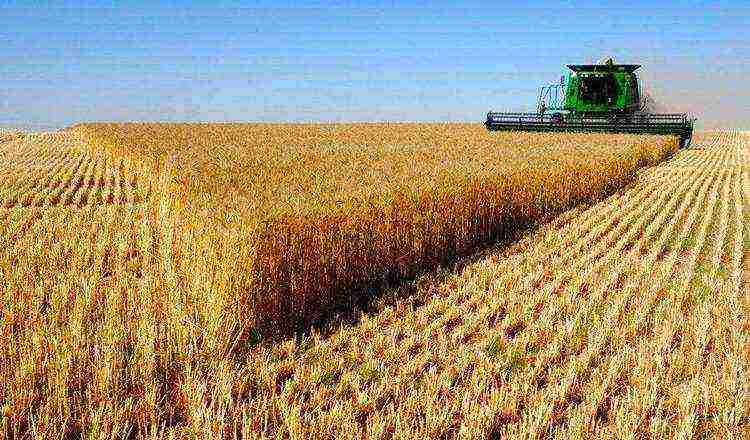
In Russia, there is a problem of shortage of flour from durum wheat. Manufacturers are tempted to save their money by diluting expensive durum flours with cheaper soft flours in the production process. That is, when buying pasta from hard varieties of a domestic manufacturer, there is a small chance of purchasing a low-quality product.
The trouble is that, according to current standards, unscrupulous manufacturers can hardly be caught in deception. The existing GOST implies only one outdated method for determining the admixture of soft flour. It allows you to identify more than 10% or less than 10% of the soft flour contains the product. In GOST there are restrictions on the content of such flour at 15%, but it is physically impossible to measure it.
Another method of testing in laboratory conditions allows you to check the proportion of soft flour by the content of protein and dry matter passed into the water. But the data obtained is not entirely accurate.
That is, it is difficult to check an unscrupulous manufacturer. Which is what some people use.
Doctor of Biological Sciences Vladimir Dukharev believes that in Russia there is a problem with the uncontrolled use of soft flour of groups B and C in the production of pasta from durum wheat flour. Usually not the largest or well-known manufacturers are guilty of this. But still, according to various estimates, the share of such products is 30-40% of the market.
But it’s not that bad. I recommend that you familiarize yourself with a large-scale study in assessing the quality of spaghetti on the Russian market, which was conducted by Roskachestvo and Rospotrebnadzor. The fan research has shown that the domestic spaghetti market can be called high-quality and highly competitive. Russian manufacturers, for the most part, are not inferior in quality to eminent Italian brands.
My Top 5 Durum Wheat Pasta
I have tried many different brands and types of pasta. Over time, I have reduced to 5 the number of pasta makers that I like more than others.
For my recipes, I buy the following brands of pasta in stores:
- Barilla
- Shebekinskiy
- LEVANTE
- Agnesi
- Trattoria di maestro Turatti
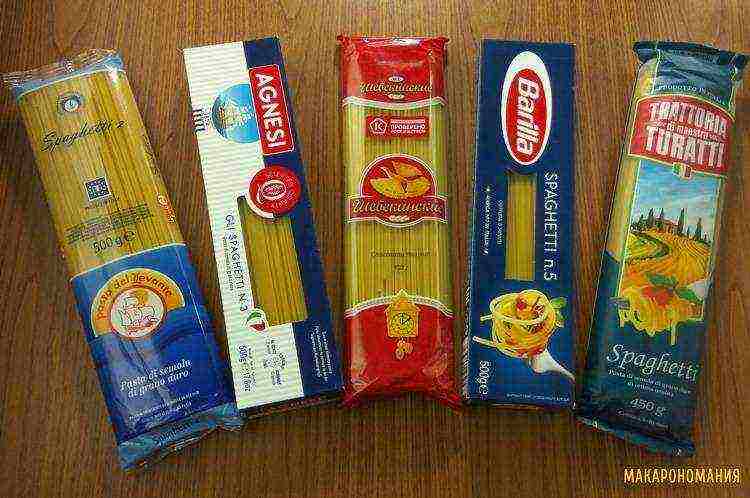
These pasta do not boil over, do not stick together during cooking, and then remain elastic. They contain a large amount of protein (from 12 g), look good and taste good.
In part, this choice was helped by me to make supermarkets within walking distance from home. Since I am limited by their range. But the choice is still good, and the cost also plays a role. Usually I don't take pasta more expensive than 120 rubles per 0.5 kg. Only if they have some unusual form of pasta that I haven’t cooked yet or interesting packaging.
Nobody paid me for advertising. Although it is probably worth contacting the manufacturers that are higher =).
This is my subjective choice of pasta based on my culinary experience and 3 years of running a pasta site.
You can write your favorite pasta brand in the comments. If I see it in the store, I'll take it for a test.
Found a bug? Please select it and press Ctrl + Enter.
Tips
Many people think that pasta should be avoided like fire, especially when dieting. We will tell you if this is so and what to look for when choosing the perfect pasta.
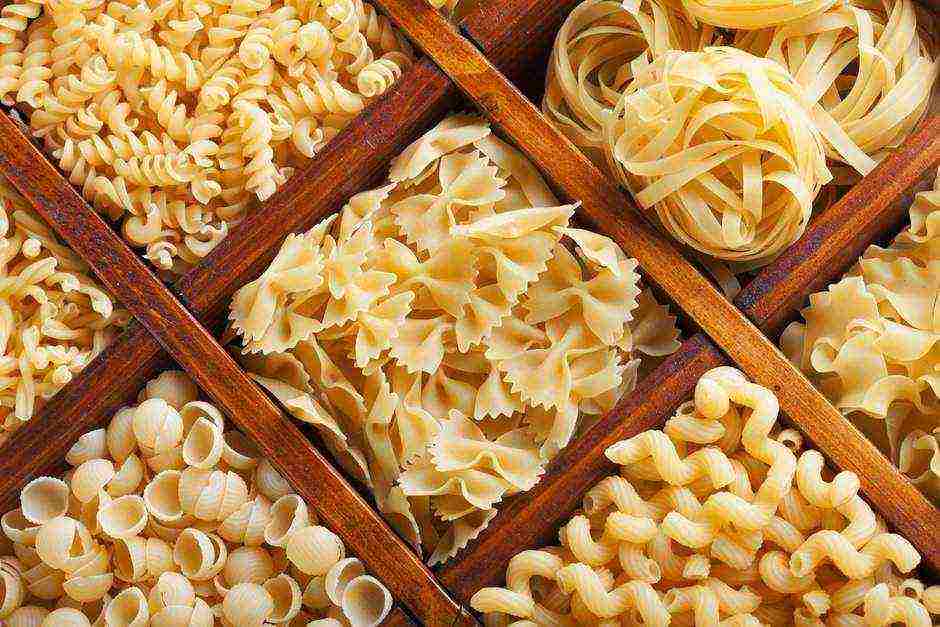 Many people believe that pasta should be avoided like fire, especially if you are keeping fit and on a diet. This product is automatically blacklisted, which is completely unfair.
Many people believe that pasta should be avoided like fire, especially if you are keeping fit and on a diet. This product is automatically blacklisted, which is completely unfair.
Of course, there are a lot of low-quality products on the shelves today, which are devoid of any useful properties. But the same cannot be said about real pasta. The problem is not finding willpower and giving up pasta, but learning how to choose the right pasta. And it's not difficult at all if you know what to look for when buying.
Benefits of the right pasta
A good paste contains all the vitamins and minerals you need.B vitamins strengthen the nervous system and relieve headaches, vitamin E prevents aging, tryptophan helps to get rid of depression and insomnia, and fiber cleanses of toxins and toxins, and also contributes to a long feeling of satiety. Manganese, potassium, iron and phosphorus are well absorbed by the body and help it to function fully.
1. Two components
Real pasta consists of only two ingredients - water and flour. It is on the quality of these two components that the taste of the pasta, its benefits or harms will depend.
The maximum that can be added to the paste is color additives (carrots, spinach, some spices, cuttlefish ink, and others). The presence of natural dyes should be indicated on the packaging.
2. Durum wheat
Pay attention to the flour that the pasta is made from. Correct pasta is made only from durum wheat. Due to the complex structure of carbohydrates and the absence of fat, they are completely absorbed by the body. Therefore, these pasta do not get fat, unless you lean on fatty sauces.
But pasta from soft wheat contains starch, which makes them more nutritious than white bread. It is these products that cause excess weight.
The correct pasta label will say: "1st class", "group A", "durum wheat". It is worth avoiding products with the inscriptions: "group B", "soft wheat flour", "2nd class".
3. Appearance
Sometimes manufacturers mislead buyers by saying that their pasta is made from durum wheat. In order not to blindly trust the manufacturer, we recommend that you carefully consider the selected paste. Proper pasta will have a smooth surface, golden yellow or amber color, a smooth edge, and small splashes on the pasta (due to grain handling). And no debris in the package! Soft pasta, even if the label says other information, will be pale or unnaturally bright in color, with a rough surface, uneven edges, white dots on the pasta and crumbs in the package.
4. Protein content
A very important indicator is the amount of protein indicated on the label. Good durum pasta has a protein content of 12 to 15 grams per 100 grams of pasta.
In bad pasta, the protein content in 100 grams is no more than 10 grams. This indicator should always be considered when choosing. The higher the protein content, the better the pasta.
5. Pack price
The price of good pasta is always higher. If the price tag is below a dollar per pack, then you are offered to buy pasta made from soft flours. Good pasta is more expensive. And if you love the perfect pasta, then give preference to the premium segment.
6. House check
Firstly, soft wheat spaghetti breaks easily, and durum pasta bends well and is strong enough.
Secondly, when cooking, the correct paste does not stick together, it has a minimum spreadiness. Even cooked, it remains a pleasant golden yellow color. Plus, a good paste will hold its shape even if left in water for several hours.

